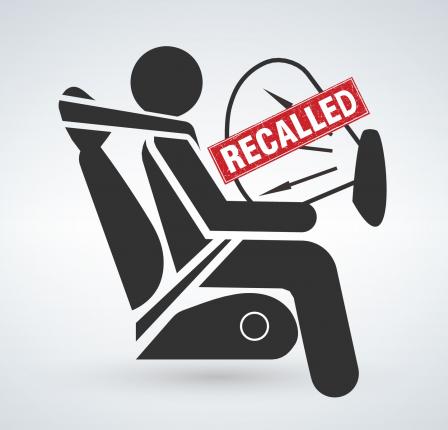Interim Final Rule: Safe Management of Recalled Airbags
On this page:
Rule Summary
EPA is issuing, with good cause, this interim final rule in response to the urgent public health issue posed by recalled Takata airbag inflators still installed in vehicles. With this rule, EPA is facilitating a more expedited removal of defective Takata airbag inflators from vehicles by dealerships, salvage yards and other locations for safe and environmentally sound disposal by exempting the collection of airbag waste from hazardous waste requirements as long as certain conditions are met.
What does the interim final rule do?
This rule provides a conditional exemption from the Resource Conservation and Recovery Act (RCRA) hazardous waste requirements for entities that remove airbag modules and inflators (i.e. airbag waste) from automobiles. Under this rule, the entities that generate the airbag waste are “airbag waste handlers” and include automobile dealerships, automotive salvage and scrap yards, independent repair facilities and collision centers. EPA is exempting from the RCRA hazardous waste requirements the generation and accumulation of airbag waste at the airbag waste handler location and during transport to an airbag waste collection facility or designated facility, as long as certain conditions are met. Once collected at the airbag waste collection facility, the airbag waste will be managed as RCRA hazardous waste and must be sent to RCRA disposal or recycling facilities.
Why is EPA issuing this interim final rule now?
In 2015, the U.S Department of Transportation's (U.S. DOT) National Highway Traffic Safety Administration issued a Coordinated Remedy Order for the recall of defective Takata airbag inflators, finding that it is imperative to accelerate the rate of the Takata recalls because each airbag inflator had the capacity to rupture when deployed, presenting an unreasonable risk of serious injury or death.
Further, the risk with the airbag inflators increases with time and exposure to heat and humidity. In 2018, Takata underwent a restructuring due to bankruptcy and U.S. DOT amended its Preservation Order regarding returned inflators. Under the amended order, vehicle manufacturers are no longer required to send recalled inflators to Takata warehouses for long-term storage but may now send them directly for disposal. With this critical interim final rule, EPA is further facilitating airbag management away from long-term storage and to final disposal.
While the Takata recall is the impetus for the rule, the airbag waste exemption also includes non-Takata airbag waste. Managing all airbag waste under the same protective requirements will avoid confusion, increase efficiency and will help prevent non-Takata airbag waste from being diverted into the municipal waste stream.
The rule was effective immediately upon publication in the Federal Register on November 30, 2018. EPA will consider the comments received in determining whether any additional revisions to the regulation of airbag waste are necessary in the future.
Webinars
EPA held two webinars about this interim final rule on November 30, 2018 and December 6, 2018. Find out more, check out the presentation slides and listen to a recording of the November webinar by clicking the red "View Archive" button when you get to the CLU-IN web page.
Rule History
 In May 2015, the U.S. Department of Transportation announced a national recall of airbag inflators manufactured by Takata due to a defect in their phase-stabilized ammonium nitrate (PSAN) propellant, which has resulted in fifteen deaths and at least 250 injuries in the United States as of August 2018. These airbag inflator recalls constitute the largest automotive recall in U.S. history, with 19 vehicle manufacturers affected and approximately 65 to 70 million airbag inflators scheduled to be recalled by December 2019.
In May 2015, the U.S. Department of Transportation announced a national recall of airbag inflators manufactured by Takata due to a defect in their phase-stabilized ammonium nitrate (PSAN) propellant, which has resulted in fifteen deaths and at least 250 injuries in the United States as of August 2018. These airbag inflator recalls constitute the largest automotive recall in U.S. history, with 19 vehicle manufacturers affected and approximately 65 to 70 million airbag inflators scheduled to be recalled by December 2019.
EPA received a number of questions regarding how the defective recalled Takata airbag inflators were regulated under RCRA. In a June 23, 2017 memorandum, EPA clarified that the recalled Takata airbag inflators are not subject to RCRA Subtitle C regulatory requirements while they are being held under the DOT Preservation Order. This memo is still in effect and can be accessed here (3 pp, 783 K, About PDF).
Now that the Takata bankruptcy and U.S. DOT’s 2018 amended Preservation Order have occurred, EPA’s action through this interim final rule is necessary to facilitate the expedited removal of defective Takata airbag inflators from vehicles as well as moves airbag management away from long-term storage and towards final disposal.
State Implementation
This interim final rule makes changes to the federal hazardous waste program that are less stringent and thus, authorized states are not required to adopt them. Affected entities should check with their state regulatory agency to determine if the conditional exemption for airbag waste is available for them to use.
Additional Resources
- Where is the Safe Management of Recalled Airbags Rule in Effect?
- More information about the Takata Recall
- 2017 EPA Takata Airbag Memo (3 pp, 783 K, About PDF)
- 2018 EPA Memo, “Regulatory Status of Automotive Airbag Inflators and Fully Assembled Airbag Modules” (note that the exemptions and exclusions described in this memo can still be used)
- View webinar details and presentations slides
- Access a recording of the webinar held in November about this interim final rule
- Frequent Questions About the Regulation of Airbag Waste
Related Resource
- Safe Handling, Storage and Treatment of Waste Fireworks - this memorandum contains best management practices and standard operating procedures to promote safer management of explosive wastes.
- About energetic hazardous wastes and treatment technologies
